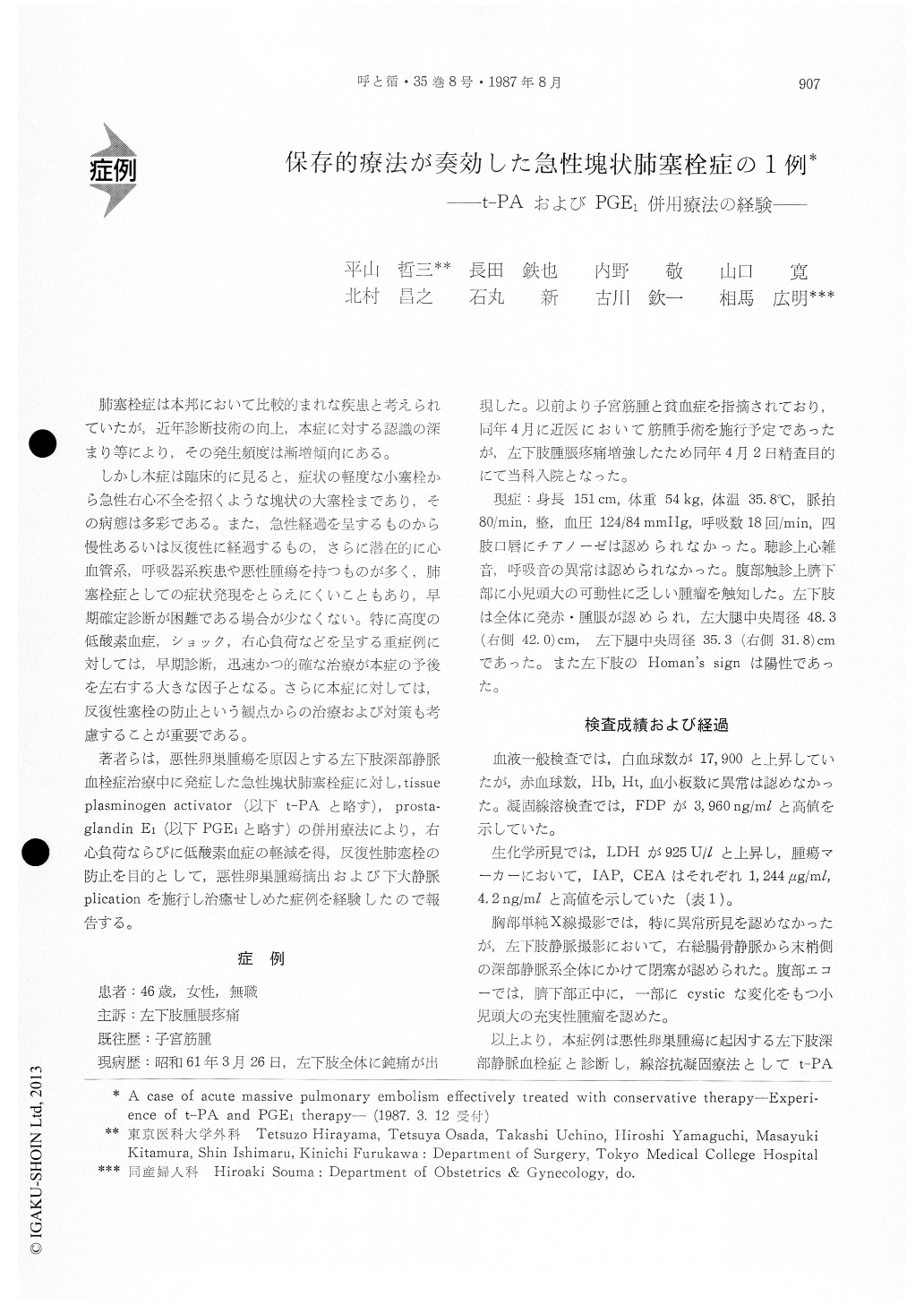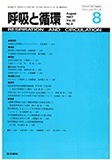Japanese
English
- 有料閲覧
- Abstract 文献概要
- 1ページ目 Look Inside
肺塞栓症は本邦において比較的まれな疾患と考えられていたが,近年診断技術の向上,本症に対する認識の深まり等により,その発生頻度は漸増傾向にある。
しかし本症は臨床的に見ると,症状の軽度な小塞栓から急性右心不全を招くような塊状の大塞栓まであり,その病態は多彩である。また,急性経過を呈するものから慢性あるいは反復性に経過するもの、さらに潜在的に心血管系,呼吸器系疾患や悪性腫瘍を持つものが多く,肺塞栓症としての症状発現をとらえにくいこともあり,早期確定診断が困難である場合が少なくない。特に高度の低酸素血症,ショック,右心負荷などを呈する重症例に対しては,早期診断,迅速かつ的確な治療が本症の予後を左右する大きな因子となる。さらに本症に対しては,反復性塞栓の防止という観点からの治療および対策も考慮することが重要である。
A 47 year-old-woman suffered from acute massive pulmonary embolism caused by deep vein throm-bosis was successfully treated with tissue plasminogen activator (t-PA) and prostagrandin E1(PGE1).
This patient came to our hospital with swelling and pain in the left lower extremity as the chief complaint. She had been suffering from ovarian tumor, and scheduled for an operation at a nearby hospital. On admission, general condition was good with blood pressure at 124/82 mmHg and heart rate at 80/min, but a malignant ovarian cyst was detected by abdominal echography. As phlevography of the left lower extremity revealed obstruction of the deep veins, intravenous injection of 24,000 unit t-PA and 2,500 unit heparin was instituted.
At 5 days after starting treatment, dyspnea andtachycardia suddenly occurred with a fall in blood pressure (98/50 mmHg) and hypoxia (Pao2 39 mmHg). Cardiac catheterization and pulmonary angiogram by digital subtruction angiography (DSA) showed severe pulmonary hypertension (80 mmHg) and a defect in right pulmonary artery.
The condition was diagnosed as acute massive pulmonary embolism originating in a deep vein thrombus, and preoperative arrangements were made for thrombectomy under cardiopulmonary bypass. In the meantime, 48, 000 unit t-PA and 5, 000 unit heparin were intravenously administered, with re-sulting rising of blood pressure (120/70 mmHg) and improvement of hypoxia (Pao2 66 mmHg). However, right ventricular pressure (RVP) remained as high as 80 mmHg, for which PGE1 was administered. RVP dropped to 50 mmHg after roughly 2 weeks of PGE1 treatment.
Operation of ovarian cyst and plication of inferior vena cava was performed at about 1 month after the onset of pulmonary embolism. Postoprative pro-gress was good, and pulmonary arteriogram by DSA showed that defect disappeared.
It is generally agreed that the anticoagulant and thrombolytic therapy should be initiated immediately after the diagnosis of acute massive pulmonary embolism, but more discussion is necessary about the indications for surgery. In our experience, thrombo-lytic therapy with t-PA brought about rising of blood pressure and improvement of hypoxia, and the administration of PGE1 lessened the overload of right ventricule. Though, urokinase or streptkina-se is commonly used in the thrombolytic therapy today, the present patient responded very well to t-PA. To prevent recurrence of pulmonary embolism, it is very important to treat the causative disease appropriately.

Copyright © 1987, Igaku-Shoin Ltd. All rights reserved.


